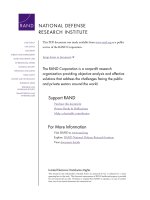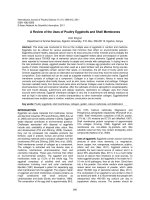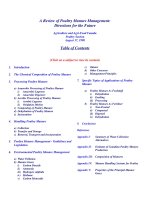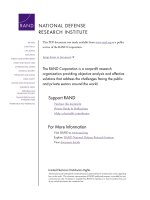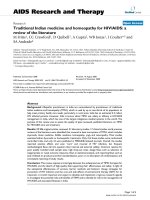Breeding crops for organic agriculture: A review
Bạn đang xem bản rút gọn của tài liệu. Xem và tải ngay bản đầy đủ của tài liệu tại đây (282.7 KB, 7 trang )
Int.J.Curr.Microbiol.App.Sci (2018) 7(11): 965-971
International Journal of Current Microbiology and Applied Sciences
ISSN: 2319-7706 Volume 7 Number 11 (2018)
Journal homepage:
Review Article
/>
Breeding Crops for Organic Agriculture: A Review
Shailja Sharma and Sanchit Thakur*
Department of Crop Improvement, CSKHPKV, Palampur-176062, India
*Corresponding author
ABSTRACT
Keywords
Breeding crops,
Organic agriculture
Article Info
Accepted:
10 October 2018
Available Online:
10 November 2018
In this review article, we describe various underlying principles and techniques behind
breeding crops for organic agriculture. As we know, according to standards of organic
agriculture, genetic engineering or its use in any which way is restricted. Basically organic
agriculture is based on the underlying principles of health, farmers, ecology and care. The
norms that derive organic agriculture are product oriented. Most of the varieties used for
organic agriculture are derived from conventional plant breeding which are input
responsive. Thus, there is a need to breed varieties especially for organic agriculture to
unlock its full potential.
organic conditions. Such varieties can ensure
quality along with yield in organic section.
Introduction
Organic farming or biodynamic farming is
quite different from conventional or nonorganic farming in respect that is aims to
increase dependence on natural biological
systems. In non-organic agriculture, such
systems are not important as it is highly
focused on dependency of crops on external
and synthetic inputs and exploitation of
natural biological systems at all levels starting
from a sub-gene level.
Thus, difference in varieties suitable in both
two approaches is very different. Due to
various constraints of non-organic breeding
programmes, the varieties developed cannot
be able to unlock full potential of organic
agriculture. So, there is a need to develop
varieties which are specifically bred under
General guidelines for
breeding methodology
organic
plant
General guidelines for organic plant breeding
methodology which are currently accepted can
be summarized in the following points:
The main aim of organic plant breeding
should be to develop those cultivars that
unlock full potential of organic farming
respecting natural biological systems i.e.
should be based on fertile plants which can
maintain viable relation with living soil and
respects barriers that exist in nature.
Clearly, methods that do not respect plant
integrity especially those that operates below
965
Int.J.Curr.Microbiol.App.Sci (2018) 7(11): 965-971
cell level are prohibited e.g. GM, CMS
hybridization with restorer gene, protoplast
fusion etc.
If F1 hybrid is fertile and can easily propagate
under organic conditions, then only the F1
hybrid production is permitted.
DNA marker assisted selection can be allowed
only if GMOs and radiations are not involved
in marker production.
Meristem culture can be used for virus
elimination. As patenting of material leads to
restrictions on its free exchange among
breeders and farmers. So, it is not allowed.
achieve optimal economic yield without
exhausting natural resources. Organic farming
should not only be environment friendly but
should be regarded as a best source of
wholesome food. When people were asked
why organic food is better for them, most of
the people said that organic foods are free
from harmful chemicals and residues (De
Waart, 1998). Organic food should not only
mean absence of chemicals but should provide
a quality food. Most of the varieties used for
organic farming are bred for non-organic
farming so there is a need to develop varieties
for organic section to improve quality and
yield (Fig. 1).
Various parties in organic breeding
Breeding objectives
Breeding objectives in case of organic
agriculture are quite different in range and
level as well as in priority from non-organic
agriculture despite of various overlaps like
yield, disease resistance etc. Weed
competitiveness is important in case of
organic agriculture which is not the priority in
non- organic agriculture. Yield has a
comparatively lower priority in organic
breeding as compared with conventional
agriculture.
A vision on organic plant breeding
The vision of organic plant breeding is based
on principles of ecology, health, care and
farmers.
Vision on organic plant breeding is covered in
following topicsEnvironmentally friendly
friendly organic agriculture
and
Mainly three parties i.e. farmers (producers),
trade and industry (manufacturers) and
breeders (gene banks, seed companies etc) are
involved in production starting from breeder
to consumer. Farmers are dependent on
organic fertilizers and N-fixing mineral inputs.
Also, farmers have knowledge of which
variety is good and is also aware of local
circumstances, conditions and limitations. On
the other hand, trade and industry demands
products that meet the required standard.
Mostly consumers required unprocessed food
free from chemicals and synthetic additives.
Lastly, breeders should maintain and develop
varieties in a sustainable manner taking care
the principles of organic agriculture. Varieties
should be bred and tested under organic
conditions so that they can provide good yield
even in low input conditions. Most important
conviction which unite these three links in
production chain is that these all should
respect wholeness of living entity.
people
Criteria at farm level
Without the use of synthetic chemicals,
fertilizers, pesticides, herbicides, growth
hormones etc, organic producers should try to
As far as organic agriculture is concerned
most principle pertain to management of farm.
Natural self-regulation, agro-biodiversity and
966
Int.J.Curr.Microbiol.App.Sci (2018) 7(11): 965-971
closed production cycles forms the basis of
organic production. Organic farms should
have to be closed nutrient cycles to reduce
closer to minimum. This can be done by
uniting aerable and livestock production,
either by forming mixed farming systems in
farms or by collaboration between farms that
are specialized according to Partner farm
concept (Baars, 1998; Van der Burgt et al.,
1999) Soil fertility plays an important part in
self-regulatory agro-ecosystem. Effective
organic manure applications, biological N
fixation and good crop rotation scheme are
must for ensuring good soil fertility. Lastly,
greater the diversity of crops or the organisms
on the farms, more will be the natural selfregulatory capacity of the farm.
Criteria at plant level
At the plant level we deal with three criterianatural reproductive ability, ability to adapt
independently to environment and genetic
diversity. Side by side respecting species
characteristics
and
natural
species
authenticity. Natural reproductive ability
means varieties should have a potential to
carry out reproduction in natural conditions
which automatically excludes any of the steps
like fertilization which is carried out in
laboratories.
Varieties which are grown organically should
be resilient and flexible as far as the
environment is concerned. They should be
adapted to the seasonal in situ fluctuations in
availability of nutrients in soil. Nutrient
mobilization of plant (Scheller, 1988) is a
combination of more efficient N uptake and
deeper rootage there should be a balance
between varieties that are bred for a particular
environment and varieties that are bred
specially for particular conditions. As
synthetic herbicides are not allowed in organic
farming, so crop must have vigour and
competitiveness to suppress weeds at earlier
stages of growth. Weed suppressive ability is
an important criteria in organic plant breeding
(Muller, 1998). Varieties should also have
resistance to diseases and plagues. Absolute
monogenetic resistance is not desirable in
organic production as it can be easily broken
so polygenic resistance is the need of the hour.
Many factors like plant structure, growth
pattern and heterozygosity all contribute to
resistance, tolerance and restorative ability.
So, we can say that use of heterozygous
varieties is more beneficial than a mix of
homozygous varieties in field. Genetic
diversity in crop species should be fully
utilized side by side is respecting natural
species authenticity. The corporate mergers
are also contributing to the narrowing the
genetic basis of plant breeding programmes
(Haselmans, 1998). Also too strong focus on
quantity or yield should not result in ignoring
quality of crops or it’s nutritional value.
Ability to mature and harmony in plant’s
gestalt are important factor’s pertaining to
food quality (Bauer, 1988) (Fig. 1; Table 1
and 2).
Socio economic criteria
Conventional plant breeding has many
disadvantages as it is mainly focused on
development of standard varieties which do
not take into consideration organic farming
conditions. These limitations are institutional,
technical, economical and conceptual in nature
(Hardon et al., 1993).
Organic plant breeding should be interactive
as compared to conventional breeding so that
farmer’s needs along with industrial or trade
requirements are given importance and
making full use of all the wisdom and
experience of the farmer. Breeding system
involves selecting varieties in natural
conditions in which farmer can play important
role. This approach is also known as
participatory plant breeding.
967
Int.J.Curr.Microbiol.App.Sci (2018) 7(11): 965-971
Table.1 The criteria of organic plant breeding, on the basis of principles of organic agriculture
Source: Lammerts van Bueren, E.T., Hulscher, M., Jongerden, J., Ruivenkamp, G.T.P., Haring, M., van Mansvelt,
J.D. and den Nijs, A.M.P., 1999. Sustainable organic plant breeding: Final report-a vision, choices, consequences
and steps.
Table.2 A summary of breeding techniques and their suitability in plant breeding
Source: Lammerts van Bueren, E.T., Hulscher, M., Jongerden, J., Ruivenkamp, G.T.P., Haring, M., van Mansvelt,
J.D. and den Nijs, A.M.P., 1999. Sustainable organic plant breeding: Final report-a vision, choices, consequences
and steps.
968
Int.J.Curr.Microbiol.App.Sci (2018) 7(11): 965-971
Fig.1 The three main parties of organic plant breeding chain
Fig.2 A flow chart of organic plant breeding and propagation
Source: Lammerts van Bueren, E.T., Hulscher, M., Jongerden, J., Ruivenkamp, G.T.P., Haring, M., van Mansvelt,
J.D. and den Nijs, A.M.P., 1999. Sustainable organic plant breeding: Final report-a vision, choices, consequences
and steps.
hybrids in case of organic agriculture can only
be justified in case of following:
Choosing breeding techniques
Techniques at plant and crop level
Unavailability
of
propagating varieties.
When hybrids are used, F1 progeny should not
be propagated by means of generative
propagation rather should be maintained by
repeatedly crossing parent lines. Using
comparable
seed
F1 can be used as a cross parent and is sterile.
969
Int.J.Curr.Microbiol.App.Sci (2018) 7(11): 965-971
Homozygous lines having sufficient vigour so
that they can be propagated easily.
Breeding
Varieties that are considered to be suitable for
organic agriculture would not need to be bred
for organic farming straightaway. For other
varieties, there should be an effort to breed for
organic agriculture as soon as possible.
Techniques at cell level
Breeding techniques at cell level fall in grey
category between the accepted and not
accepted ones. As we know that cell is the
smallest living entity and cell techniques
could be used without violating organic
principles to work only with living entities.
Genetic sources
As list of available gene bank stocks should
be prepared taking into consideration the
characteristics that are required for organic
farming. In this way, required genetic stocks
are easily found.
On the other hand, farmers only deal at plant
level which is smallest unit in relation to
environment. Therefore, use of techniques at
cell level is still a controversy.
Gene bank stocks that are selected should be
screened for desirable characteristics.
Protoplast Fusion
This technique is also rejected in organic
plant breeding because this is only applicable
when two species differs too much that they
could not be crossed under natural conditions
which is against the principles and ethics of
organic plant breeding.
Organic trials of these gene bank stocks based
on primary selection can lead to the formation
of suitable foundation stock.
Simulating plant breeding programmes
Cytoplasmic male sterility
To obtain a good understanding of organic
plant breeding, breeders should follow
courses in organic agriculture.
Organic agriculture respect use of techniques
that interfere with plant’s natural reproductive
ability. As if now the sector particularly
opposes CMS hybrids that are used without
having restorer genes.
Collaboration between individual breeders,
breeding companies and organic farmers is
must.
Participatory plant breeding approach should
be followed.
Artificial induction- According to vision of
organic plant breeding, direct manipulations
at DNA level is undesirable. Thus, we can say
artificial induction like mutation in DNA by
radiation or chemical mutagens etc is
unsuitable in this sector.
Organic plant breeding is confined to specific
breeding techniques and in general those
crossing methods that do not lead to breakage
of reproductive barriers species and selection
methods that are based on individual plant
performance i.e. backcrossing, mass and
individual selection, selection via DNA
markers, hybrid cultivars, meristem culture,
intraspecific crossing. On the other hand
technologies interfering at DNA level are
Techniques at DNA level
Genetic
modifications
are
absolutely
prohibited or techniques at DNA level are
strictly prohibited.
970
Int.J.Curr.Microbiol.App.Sci (2018) 7(11): 965-971
regarded as incompatible. Participatory plant
breeding and evolutionary breeding are
regarded as suitable breeding methods for
organic farming.
Haselsmans, M. 1998. De plant als machine.
NRC
Handelsblad
20-1-1998,
Rotterdam.
Keulen (ed.), 1998. Mixed farming systems in
Europe. AP Minderhoudhoeve-reeks nr
2 (1998). Wageningen Agricultural
University.
Muller, K.J. 1998. Erweiternde Kriterien fur
die Zuchtung von sommerspeisegersten
in Organische Landbau, Schriftenreihe
institute fur organische Landbau, Verlag
Dr. Koster, Berlin.
Scheller, E. 1988. Die Stickstoffversorgung
der Pflanzen aus dem Stickstoffwechsel
des bordens. Ein Beitrag zu einer
Pflanzenernahrungslehre
des
Organischen Landbaus. Verlag J.
Margraf Weikersheim.
Van der Burgt, Baars GT and Nauta W. 1999.
Koppelbedrijven (in progress).
References
Baars T. 1998. Modern solutions for mixed
systems in organic farming. In: H. van.
Bauer D. 1998. Harmonie, internal
publication. Dottenfelderhof.
De Waart S. 1998. Voeding Biologisch: goed,
beter, best/Biologische en gangbare
groenten en fruit vergeleken: een
overzicht. Louis Bolk
Instituut,
Driebergen.
Hardon, J., and W De Boef. 1993. In: De
Boef, W., K. Amanor and K. Wellard.
Cultivating
Knowledge,
genetic
diversity, farmer experimentation and
crop research. IT Publications.
How to cite this article:
Shailja Sharma and Sanchit Thakur. 2018. Breeding Crops for Organic Agriculture: A Review.
Int.J.Curr.Microbiol.App.Sci. 7(11): 965-971. doi: />
971

